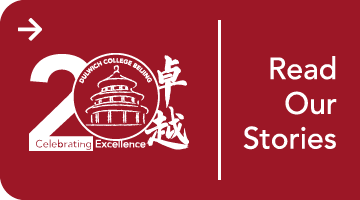Meet our Senior School Mathematics team!
“Mathematics” … What does this word evoke to you? Maybe the beauty of pure rigour and logic for some, a dreaded nightmare for others, and every shade of interest and challenges in between? In short, mathematics is one of those subjects that has left no generation of students indifferent. But why? How has education in mathematics evolved over the years, and how does it look here in Dulwich College Beijing (DCB)?
We’ve met our passionate team of mathematics teachers in Senior School to crack the secrets of their teaching philosophy. Believe it or not, but our bubbly teachers, as they described themselves, cumulate 105 years of maths teaching experience!! With such extensive experience to share, the team has ample room for lively maths and education-related discussions alongside friendly banter, resulting in a supportive team always willing to help and learn from each other.

Starting with an easy task, we asked them how they would summarize maths teaching at DCB.
The unanimous answer was “both rewarding and challenging”. How is that so?
Rewarding
Firstly, being an international school, our students display a cultural mix that is reflected in their approach to mathematics. This provides us, as educators, the opportunity to be exposed to and learn from other maths methods.
Secondly, our students are self-driven. Most have strong foundations in mathematics with the capability to understand new mathematics quickly. They show a mix of intrinsic and extrinsic motivation for mathematics that comes from both the cultural environments that traditionally holds mathematics in high regard and their personal commitment to thrive and be the best at mathematics. They are eager to learn beyond the limitations of syllabus or textbooks, constantly seek opportunities to deepen their understanding and apply their mathematics knowledge to other subjects or real-life problems. This is consistent with our own philosophy that mathematics is not only important in its own right but can also serve as a connecting bridge to other subjects.
Challenging
Such endless curiosity and a strong appetite for mathematics push us, teachers, to follow our students’ lead and “go above and beyond”. This includes discussing advanced questions, tackling beyond-textbook problems, regularly satisfying their desire to be engaged in mathematics, to name but a few. Students themselves are continuously learning about mathematics, whether in the classrooms or outside of school, through a wide range of ECAs, challenges and competitions. This translates into a fast-paced, advanced teaching and learning process that is rather unique to the DCB environment. Ultimately, this triggers a lot of intellectual and academic pressure on mathematics from students and the wider community. We can also see peer pressure among the students despite our emphasizing that each student has his/her own path and that focusing on the mathematics journey would help to fully appreciate “the beauty of mathematics”.
Moving forward, the next step was to understand their teaching philosophy further and figure out how students nowadays build up maths skills in an era where most basics information are available online.
That’s where the secret lies! The world is moving away from teaching students to just “do maths”, and putting more emphasis on the understanding of mathematics as well as the understanding of how and when that maths can be applied. In short, students are no longer expected to become “walking computers”, experts at learning and regurgitating set methods to solve problems. They are instead expected to develop the skills and knowledge to master concepts in order to address a given problem or situation creatively, searching through their existing knowledge and trying out different approaches to ultimately find a suitable pathway to a solution, which they can justify. This requires more thinking, more maths maturity and cognitive skills such as creativity and reasoning, to be able to analyse a given problem and identify the different potential angles to tackle it.
Mathematics has indeed become a more creative thinking subject. Needless to say, this shift requires teachers and students to adopt more suitable teaching methods. The foundations of problem-solving may start in Junior School, then build up in Key Stage 3 in a more formal way as students are regularly presented with new situations that require creative use of the mathematics they have learned to solve. By the time they reach IB, they know how to leverage their mathematics skills to complete research-based investigations such as Extended Essay and Internal Assessment, both of which require the ability to explore the mathematics in a particular situation independently.
For our most passionate students, there are also opportunities to develop their mathematical skills and curiosity beyond the curriculum, outside the classrooms, and DCB provides a vast array of enrichment opportunities for our budding mathematicians to explore their potential further. To name but a few, all students participate in the United Kingdom Mathematics Trust (UKMT) age-appropriate challenges. Year 12 students run an ECA, Competitions Maths and Training (CMIT), aiming at training younger students for competitions, or just provide maths-lovers with more opportunities to delve into mathematics problems. We also participate in the yearly Young Mathematical Story Author Competition (YMSAC) where students use their creativity and practise their ability to articulate mathematical concepts through writing a maths story, thus contributing to developing their mathematics thinking and creativity. Similarly, our House Maths also engage all students across the Senior School in friendly competitions and gives them opportunities to look at mathematics from a different perspective. Finally, our older students get opportunities to support younger students in mathematics, thereby also giving them the opportunity to share their knowledge, their passion and build up their mathematics pedagogy and creativity by adopting different strategies to teach different students.








